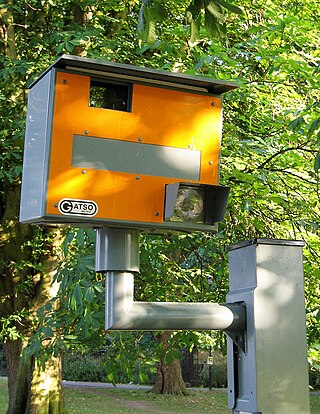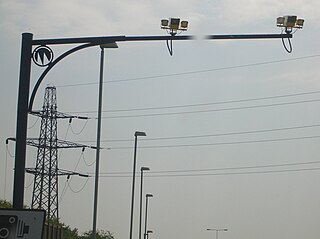It has been suggested that this article be merged into Assured clear distance ahead . (Discuss) Proposed since May 2024. |

Following distance is the space between the back of a vehicle and the front of the following vehicle in traffic.
It has been suggested that this article be merged into Assured clear distance ahead . (Discuss) Proposed since May 2024. |

Following distance is the space between the back of a vehicle and the front of the following vehicle in traffic.
In the Australian state of New South Wales, 3 seconds of following distance is recommended. [1] In Queensland, [2] Victoria, [3] and Western Australia, [4] 2 seconds is recommended.
In the European Union, the two-second rule is recommended, and in some European countries there are penalties for maintaining lower distances. [5]
In the UK, it is recommended that 2 seconds of following distance is maintained. [6]

In the US, for safety it is recommended that 3-4 seconds of following distance is maintained. [7] Extra time should be added for wet, rainy, slippery, foggy or other weather situations accordingly. [8] For heavy duty commercial vehicles it is recommended 4-6 seconds following distance for speeds under 30 mi/h (48 km/h), and 6-8 seconds following distance for speeds over 30 mi/h (48 km/h). [9] Rear-end collisions are the number one type of traffic collisions. [10]

Speed limits on road traffic, as used in most countries, set the legal maximum speed at which vehicles may travel on a given stretch of road. Speed limits are generally indicated on a traffic sign reflecting the maximum permitted speed, expressed as kilometres per hour (km/h) or miles per hour (mph) or both. Speed limits are commonly set by the legislative bodies of national or provincial governments and enforced by national or regional police and judicial authorities. Speed limits may also be variable, or in some places nonexistent, such as on most of the Autobahnen in Germany.

A traffic enforcement camera is a camera which may be mounted beside or over a road or installed in an enforcement vehicle to detect motoring offenses, including speeding, vehicles going through a red traffic light, vehicles going through a toll booth without paying, unauthorized use of a bus lane, or for recording vehicles inside a congestion charge area. It may be linked to an automated ticketing system.

In transportation, platooning or flocking is a method for driving a group of vehicles together. It is meant to increase the capacity of roads via an automated highway system.

Road traffic safety refers to the methods and measures used to prevent road users from being killed or seriously injured. Typical road users include pedestrians, cyclists, motorists, vehicle passengers, and passengers of on-road public transport.

Street-legal, road-legal, or road-going, refers to a vehicle such as a car, motorcycle, or light truck that is equipped and licensed for use on public roads, being therefore roadworthy. This will require specific configurations of lighting, signal lights, and safety equipment. Some specialty vehicles that will not be operated on roads, therefore, do not need all the features of a street-legal vehicle; examples are a vehicle used only off-road that is trailered to its off-road operating area, and a racing car that is used only on closed race tracks and therefore does not need all the features of a street-legal vehicle. As well as motor vehicles, the street-legal distinction applies in some jurisdictions to track bicycles that lack street-legal brakes and lights. Street-legality rules can even affect racing helmets, which possess visual fields too narrow for use on an open road without the risk of missing a fast-moving vehicle.

Tailgating is the action of a driver driving behind another vehicle while not leaving sufficient distance to stop without causing a collision if the vehicle in front stops suddenly.

Advanced driver-assistance systems (ADAS) are technologies that assist drivers with the safe operation of a vehicle. Through a human-machine interface, ADAS increase car and road safety. ADAS use automated technology, such as sensors and cameras, to detect nearby obstacles or driver errors, and respond accordingly. ADAS can enable various levels of autonomous driving.

The two-second rule is a rule of thumb by which a driver may maintain a safe trailing distance at any speed. The rule is that a driver should ideally stay at least two seconds behind any vehicle that is directly in front of his or her vehicle. It is intended for automobiles, although its general principle applies to other types of vehicles. Some areas recommend a three-second rule instead of a two-second rule to give an additional buffer.

A motorized scooter is a stand-up scooter powered by either a small internal combustion engine or electric hub motor in its front and/or rear wheel. Classified as a form of micro-mobility, they are generally designed with a large center deck on which the rider stands. The first motorized scooter was manufactured by Autoped in 1915.

A tram accident is any accident involving a tram or tram system.
Intelligent speed assistance (ISA), or intelligent speed adaptation, also known as alerting, and intelligent authority, is any system that ensures that vehicle speed does not exceed a safe or legally enforced speed. In case of potential speeding, the driver can be alerted or the speed reduced automatically.

A collision avoidance system (CAS), also known as a pre-crash system, forward collision warning system (FCW), or collision mitigation system, is an advanced driver-assistance system designed to prevent or reduce the severity of a collision. In its basic form, a forward collision warning system monitors a vehicle's speed, the speed of the vehicle in front of it, and the distance between the vehicles, so that it can provide a warning to the driver if the vehicles get too close, potentially helping to avoid a crash. Various technologies and sensors that are used include radar (all-weather) and sometimes laser (LIDAR) and cameras to detect an imminent crash. GPS sensors can detect fixed dangers such as approaching stop signs through a location database. Pedestrian detection can also be a feature of these types of systems.

A traffic collision, also known as a motor vehicle collision, occurs when a vehicle collides with another vehicle, pedestrian, animal, road debris, or other moving or stationary obstruction, such as a tree, pole or building. Traffic collisions often result in injury, disability, death, and property damage as well as financial costs to both society and the individuals involved. Road transport is statistically the most dangerous situation people deal with on a daily basis, but casualty figures from such incidents attract less media attention than other, less frequent types of tragedy. The commonly used term car accident is increasingly falling out of favor with many government departments and organizations, with the Associated Press style guide recommending caution before using the term. Some collisions are intentional vehicle-ramming attacks, staged crashes, vehicular homicide or vehicular suicide.

The geometric design of roads is the branch of highway engineering concerned with the positioning of the physical elements of the roadway according to standards and constraints. The basic objectives in geometric design are to optimize efficiency and safety while minimizing cost and environmental damage. Geometric design also affects an emerging fifth objective called "livability," which is defined as designing roads to foster broader community goals, including providing access to employment, schools, businesses and residences, accommodate a range of travel modes such as walking, bicycling, transit, and automobiles, and minimizing fuel use, emissions and environmental damage.

Speed limits are enforced on most public roadways by authorities, with the purpose to improve driver compliance with speed limits. Methods used include roadside speed traps set up and operated by the police and automated roadside 'speed camera' systems, which may incorporate the use of an automatic number plate recognition system. Traditionally, police officers used stopwatches to measure the time taken for a vehicle to cover a known distance. More recently, radar guns and automated in-vehicle systems have come into use.

Road speed limits in the United Kingdom are used to define the maximum legal speed for vehicles using public roads in the UK.

Road speed limit enforcement in the United Kingdom is the action taken by appropriately empowered authorities to attempt to persuade road vehicle users to comply with the speed limits in force on the UK's roads. Methods used include those for detection and prosecution of contraventions such as roadside fixed speed cameras, average speed cameras, and police-operated LIDAR speed guns or older radar speed guns. Vehicle activated signs and Community Speed Watch schemes are used to encourage compliance. Some classes of vehicles are fitted with speed limiters and intelligent speed adaptation is being trialled in some places on a voluntary basis.
In legal terminology, the assured clear distance ahead (ACDA) is the distance ahead of any terrestrial locomotive device such as a land vehicle, typically an automobile, or watercraft, within which they should be able to bring the device to a halt. It is one of the most fundamental principles governing ordinary care and the duty of care for all methods of conveyance, and is frequently used to determine if a driver is in proper control and is a nearly universally implicit consideration in vehicular accident liability. The rule is a precautionary trivial burden required to avert the great probable gravity of precious life loss and momentous damage. Satisfying the ACDA rule is necessary but not sufficient to comply with the more generalized basic speed law, and accordingly, it may be used as both a layman's criterion and judicial test for courts to use in determining if a particular speed is negligent, but not to prove it is safe. As a spatial standard of care, it also serves as required explicit and fair notice of prohibited conduct so unsafe speed laws are not void for vagueness. The concept has transcended into accident reconstruction and engineering.
The death of Elaine Herzberg was the first recorded case of a pedestrian fatality involving a self-driving car, after a collision that occurred late in the evening of March 18, 2018. Herzberg was pushing a bicycle across a four-lane road in Tempe, Arizona, United States, when she was struck by an Uber test vehicle, which was operating in self-drive mode with a human safety backup driver sitting in the driving seat. Herzberg was taken to the local hospital where she died of her injuries.
Automated lane keeping systems (ALKS), also described as traffic jam chauffeurs, is an autonomous driving system that doesn't require driver supervision on motorways. ALKS is an international standard set out in UN-ECE regulation 157 and amounts to Level 3 vehicle automation. It is essentially a more robust combination of adaptive cruise control (ACC) and lane centering assist (LCA). When activated, it allows the driver to do non-driving tasks until alerted otherwise.